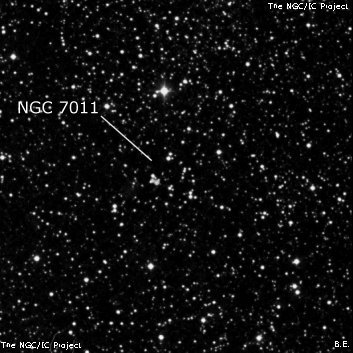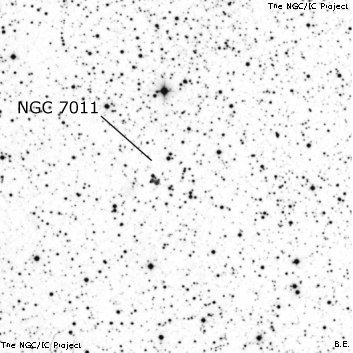NGC/IC Project Restoration Effort
(This is a very very beta version)
NGC7011


Basic Information
Location and Magnitude
Right Ascension: 21:1:50.0
Declination: +47:21:17
Constellation: CYG
Visual Magnitude:
Historic Information
Discoverer: Herschel J.
Year of discovery: 1829
Discovery aperture: 18.3
Observational
Summary description: Cl, no description
Sub-type: *Grp
Corwin's Notes
=====
NGC 7011. My original thought on JH's "cluster" reads as follows:
NGC 7011 is most likely the V-shaped group of about 15 stars 2-3 arcmin
northwest of JH's position. While he gives no more information than a
position and the brief non-description, "A cluster. No further
description," the group is very eye-catching on the DSS. There are a few
other stars scattered around it that might add to its "eye appeal" during a
sweep. Wolfgang also picked this same group when he looked at the field.
So, I've adopted the identification.
However, after correspondence with Steve Waldee in 2013, I'm no longer sure
about this -- these stars are quite faint, and may have been seen by JH as
part of the random background.
Steve has several candidates for the cluster, based on his observations with
his 11-inch Schmidt-Cassegrain. He also quotes Steve Gottlieb's observation
with a 17.5-inch reflector. All this is in an entertaining web page at
http://freescruz.com/~4cygni/haggisizing/astro/NGC7011-matter.htm which I
recommend for the interested observer.
For the record, here are the positions (J2000.0 for the SAO stars noted) and
some brief remarks on the other candidates that Steve has singled out:
21 04 58, +47 08.8 "SAO 50429 ... & NW. A f group of *s (12-13 mag)
stretching out about 2' x 3' with 50429 in SW end. Seems like a 'cluster'
..."
21 06 03, +47 10.4 "... a grouping of *s involving SAO 50450 -- looks like
2 sm r clumps of *s side-by-side, with 9th mag *, maybe 4' x 2'."
21 03 51, +47 06.4 "... definitely looks like a CL! 'Mini Cygnus' -- kite
shaped asterism of 5 *s, SAO 50410 points to the SE of grp. Peppering of
much f'er *s to N, NW -- a streamer of about 8 *s, 13th m, in a straight
line, not evenly spaced, plus a few other f'er ones. It looks like an
oddly shaped OCL."
Steve Gottlieb's candidate:
21 02 34, +47 32.7 "... a fairly bright scattered group located to the SE of
mag 7.5 SAO 50376. This group is about 5' in length and elongated NW-SE.
Near the center is the brightest star (mag 10) at [the position given].
Finally, yet another candidate from Jaakko Saloranta, a long-time
correspondent of Steve Waldee's:
20 59 49, +47 31.3 "There was a little more obvious grouping of stars north
of 4th magnitude 59 Cygni ... but it is unlikely this is what John Herschel
noted."
In all of these, I was struck by the presence of a brighter star with
considerably fainter ones nearby. In reply to Steve Waldee's query about
Jaakko's observation, I wrote:
My thinking about 59 Cyg, so much brighter than any other star in the area,
is that if it were involved in JH's cluster, he would have mentioned it
specifically, saying something like "A star 4.7 m (59 Cygni) with a few
others much fainter scattered around ..." He's made this sort of notation
with many other clusters in his catalogues, including the two in Sweep 210
that bracket NGC 7011: NGC 6991 = h2091: "A star 9 m; the largest of a
cluster" and NGC 7039 = h2107: "A star 6.7 m situated just beyond the nf
edge of a L, p rich cluster ..." (Notice in both cases that he gives the
position of the star, not the cluster itself.) 59 Cyg is so outstanding
that I think he would have done the same with it, too, if it were involved
with his [NGC 7011] cluster.
I think if JH had picked up any of the other candidates that Steve mentions,
he would also have made a comment about the brighter stars near them.
Given all of this, it's obvious that question marks have to go on the object
in the big table. While I continue to have a slight preference for the small
V-shaped asterism -- it has the advantage of being close to JH's position --
the visual observers' work has convinced me that the story is not yet settled.
This led me to dig into the Herschel Archive. NGC 7011 is object number 15 in
Sweep 210 on 19 Sept 1829. The entry for that number has JH's usual
information needed to find the position, then a "VII" which I presume is an
object class, in this case "Pretty much compressed clusters of large or small
stars", then a brief description "a sm[?] cl of vS *s." All of this is in
pretty scratchy handwriting not very well photocopied on the left page of the
observing log booklet. The right page carries over the object number and
shows (in much darker handwriting) the reduced position for 1830 that was
copied into the 1833 Observations paper (20 56 06.5, 43 20 50; note NPD, not
declination).
There is also a comment on the right page, "A Horrid Set of Zeros, but the
[two indecipherable words] stars [another scribbled short -- abbreviated? --
word or letter] agree well, [symbol for "therefore"] all right." This
suggests a possible larger uncertainty in the positions than JH usually gives
us. However, five other clusters in the same sweep (NGC 6991, 7039, 7062,
7071, and 7209) have modern positions that differ insignificantly from JH's.
So, there is apparently no large systematic error in the position of NGC 7011.
Having said all of that, I should also note that the left page of JH's log is
pretty well packed full of partially indecipherable scribbles. I'm sure JH
could make out this handwriting (probably by his observing assistant John
Stone), but until I have a lot more experience with it, anything I read has to
be taken cautiously. It may also be that the comments and descriptions are
not aligned across the page with the information for the positions; though in
this case, I believe they are.
In any event, there is the possibility that the description for NGC 7011 can
be expanded a bit. If "A small cluster of very small stars" does indeed apply
to NGC 7011, then my original identification with the V-shaped asterism might
be correct after all. It fits the description perfectly.
However, the queries remain in place.
Steve's Notes
=====
NGC 7011
17.5" (9/23/95): at the NGC position are just some scattered faint stars near a mag 9.5 star located at 21 01 52 +47 24.9. These do not appear to be worth noting at all by John Herschel. About 15' NE, though, is a fairly bright scattered group located to the southeast of mag 7.5 SAO 50376. This group is about 5' in length and elongated NW-SE. Near the center is the brightest star (mag 10) at 21 02 34 +47 32.7. Also of interest is the Milky Way, which abruptly begins off the southeast side of the low power field and is magnificent to sweep around in this region. Listed as nonexistent in RNGC.



